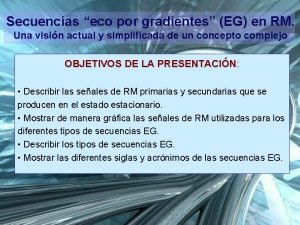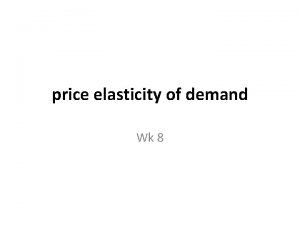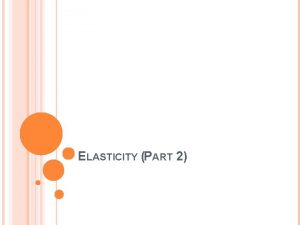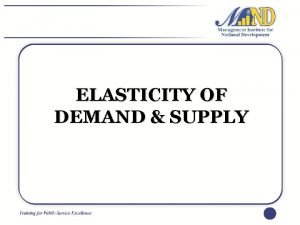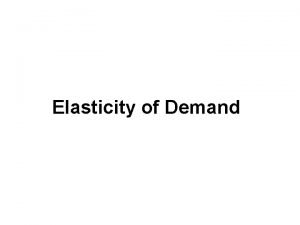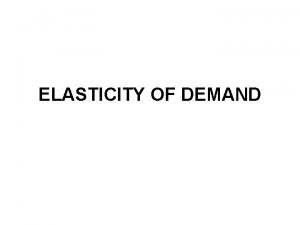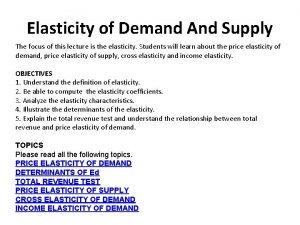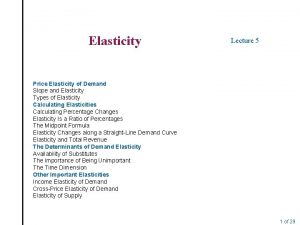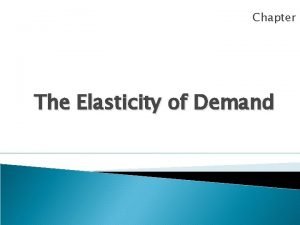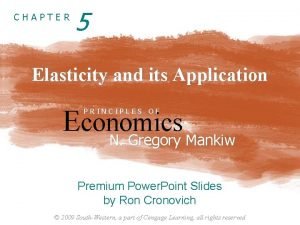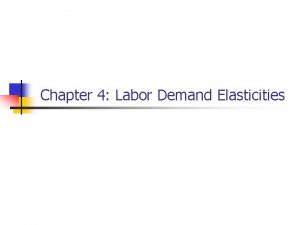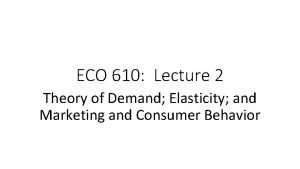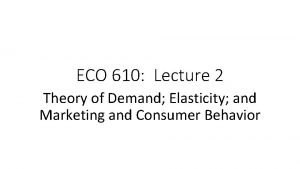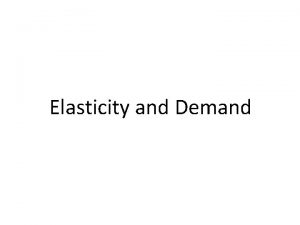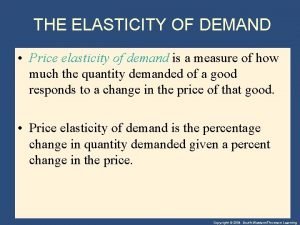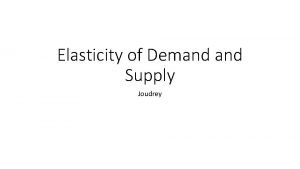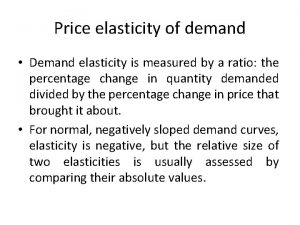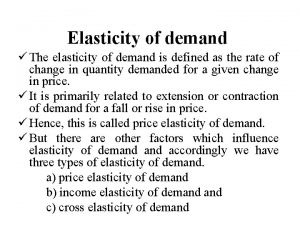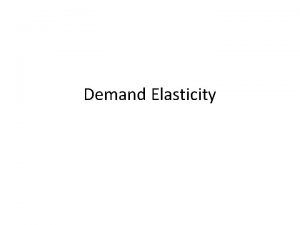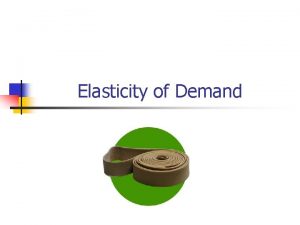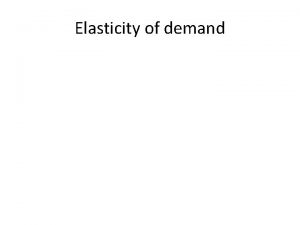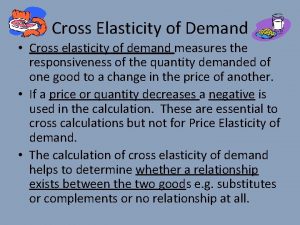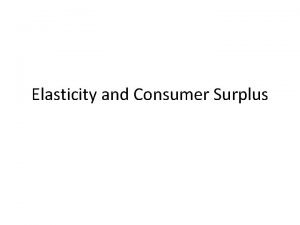ECO 610 Lecture 2 Theory of Demand Elasticity





















- Slides: 21

ECO 610: Lecture 2 Theory of Demand; Elasticity; and Marketing and Consumer Behavior

Theory of Demand; Elasticity; and Marketing and Consumer Behavior: Outline • Demand Theory and Marketing Research ØHouseholds’ demand for final goods and services ØFirms’ demand for factors of production • Elasticity ØOwn-price elasticity of demand ü Calculating elasticity ü Own-price elasticity and total revenue ü Factors affecting own-price elasticity ØIncome elasticity of demand ØCross-price elasticity of demand • Estimating demand relationships

Theory of Demand/Marketing/Consumer Behavior • What is marketing? (versus advertising) • How does one do marketing research? • What theoretical framework does one use when doing marketing research? • Who are the firm’s customers? Households or firms? What decisionmaking process do the firm’s customers use when evaluating whether or not to purchase the firm’s product? • Examples: ØBrown Forman and bourbon ØValvoline and motor oil ØAlltech and animal food supplements

Households’ demand for final goods and services • Why do households demand final goods and services? • Because households get utility from consuming goods and services. • Quantity Demanded (QD): total amount of a commodity that all households wish to purchase. • Factors affecting QD: 1. 2. 3. 4. 5. tastes or preferences income price of the product prices of other products a) b) substitutes in consumption complements in consumption other things?

Firms’ demand for factors of production • Why do firms demand inputs (factors of production)? ØBecause firms use inputs to produce outputs that can be sold for profits. • Demand for an input is derived from the demand for the final good or service the input is used to produce. • Two key economic factors in a firm’s demand for an input: ØHousehold demand for the final good or service ØExtent to which the firm is able to substitute one input for another in its production process

Marketing research example • Your team is given the following assignment: • “Pepsi. Co Pushes Breakfast in Bid to Heat Up Oatmeal, WSJ, 7/28/10. • http: //ezproxy. uky. edu/login? url=http: //search. proquest. com/docvie w/732571063? accountid=11836 • Figure out the best way to increase the demand for Quaker Oatmeal. • Where do you start? • https: //www. youtube. com/watch? v=Uh. O 1 u. OC 91 Yo • https: //www. youtube. com/watch? v=31 uj. St. Zv. El 4 • https: //www. youtube. com/watch? v=-Tw 3 AR 9 ubgw

Elasticity • Demand function: quantity demanded of good X depends consumers’ tastes or preferences, incomes, the price of good X, and the prices of other goods (like good Y, a substitute, and good Z, a complement). • Algebraically: XD = dx(Tastes, Incomes, PX , PY , PZ) • We are interested in the relationship between quantity demanded of X and each of the economic factors which influence it. We have already discussed conceptually the direction of the effect of each variable that affects XD • Now we want to consider the magnitude. If the price of X changes by a given amount, by how much will the quantity demanded of X change, i. e. how sensitive is quantity demanded to a change in price?

Three elasticities • Own price elasticity of demand: measures the sensitivity of quantity demanded of good X to a change in the price of good X • εx, Px = - (%ΔXD) / (%ΔPx) • Income elasticity of demand: measures the sensitivity of quantity demanded to a change in income • εx, Income = (%ΔXD) / (%ΔIncome) • Cross-price elasticity of demand: measures the sensitivity of quantity demanded of good X to a change in the price of good Y • εx, Py = (%ΔXD) / (%ΔPY)

Calculating Own-price Elasticity of Demand: Arc elasticity formula •

Calculating Price Elasticity of Demand for Tennis Lessons Price per Lesson ($/hr) 10 A B 8 C 4 D 2 D 5 10 15 20 25 30 Q (# of Students per week)

Examples calculating arc elasticity • Calculating εx, Px from point A to point B: P 0=10, P 1=8, Q 0=5, Q 1=10 • Calculating εx, Px from point C to point D: P 0=4, P 1=2, Q 0=25, Q 1=30

How to interpret the elasticity coefficient: • if εx, Px > 1 then we say that demand is elastic: % Q > 1 % P or % Q > % P. This occurs when consumers are relatively responsive to a change in the price of good X. • if εx, Px < 1 then we say that demand is inelastic: % Q < 1 % P or % Q < % P. This occurs when consumers are relatively unresponsive to a change in the price of good X. • if εx, Px = 1 then we say that demand is unitary elastic: % Q = 1 % P or % Q = % P.

Own-price elasticity and total revenue • “Thrill parks try to boost attendance: Some lower their fees to attract crowds, ” Lexington Herald-Leader, 5/27/06. http: //bit. ly/odth. Lq • https: //www. cedarpoint. com/play/rides-coasters • Case study: you own and operate an amusement park. Your costs are primarily fixed—once you decide on a schedule your costs do not vary much with the number of patrons in the park. • Challenge is to maximize total revenues, in so doing you will maximize profits. • If you want to increase total revenues, should you raise price or lower the price of admission?

• Suppose you raise price by 5% and the number of customers falls by 10% in response. What is own-price elasticity of demand? Does total revenue go up or down? • Suppose you lower price by 5% and the number of customers increases by 10% in response. What is own-price elasticity of demand? Does total revenue go up or down? • Suppose you raise price by 10% and the number of customers falls by 5% in response. What is own-price elasticity of demand? Does total revenue go up or down? • Suppose you lower price by 10% and the number of customers increases by 5% in response. What is own-price elasticity of demand? Does total revenue go up or down?

General principles: • If εx, Px > 1, i. e. demand is elastic, then (%ΔXD) > (%ΔPx). An increase in price will cause total revenue to fall and a decrease in price will cause total revenue to rise. • If εx, Px < 1, i. e. demand is inelastic, then (%ΔXD) < (%ΔPx). An increase in price will cause total revenue to rise and a decrease in price will cause total revenue to fall. • If εx, Px = 1, i. e. demand is unitary elastic, then (%ΔXD) = (%ΔPx). Total revenue will stay the same after either a price increase or price decrease.

Determinants of Price Elasticity • Are there economic characteristics of the product that might help us predict whether demand will be elastic or inelastic? Under what conditions will consumers be sensitive or insensitive to a change in price? ØAvailability of substitutes: if there are many good close substitutes for a product and its price increases, then consumers will. . . üDefinition of the product: the more narrowly defined is the product, the more good close substitutes there are . . . ØShare of the budget: the greater the share of their budget consumers spend on an item, the . . . sensitive they will be to a price change. ØTime to adjust: the more time that consumers have to adjust to a price change, the . . . sensitive they will be to a price change.

Examples using own-price elasticity • Residential demand for electricity—availability of substitutes. Lighting? Space heating? • Forecasting energy demand for KU/LG&E—short run vs. long run? • Supermarket advertising and loss leaders—milk or salt? • How to set excise taxes if the goal is to raise revenue—excise tax on cigarettes? Sales tax on thoroughbreds at Keeneland?

Income Elasticity of Demand • εx, Income = (%ΔXD) / (%ΔIncome) = [ΔQ / (Q 0 + Q 1)] / [ΔI / (I 0 + I 1)] • εx, Income > 0 , quantity demanded increases when income increases and vice versa. We call these Normal Goods. • εx, Income < 0 , quantity demanded decreases when income increases and vice versa. We call these Inferior Goods. • Among normal goods, if 0 < εx, Inc < 1 , i. e. consumption of a good increases when income increases, but less than proportionate to the increase in income, we call this type of a good a Necessity. • Among normal goods, if εx, Inc > 1 , i. e. consumption of a good increases when income increases, but more than proportionate to the increase in income, we call this type of a good a Luxury Good.

Examples using Income Elasticity of Demand • Kentucky Lottery Commission: what are your products? Who are your customers, i. e. what is the income elasticity of demand for the different products you sell? How would you market the different products? • Instant scratch-off games? • Daily numbers games? • Lotto games: e. g. Pick Six, Powerball? • How would you go about estimating income elasticity of demand for different lottery products?

Cross-price Elasticity of Demand • εx, Py = (%ΔXD) / (%ΔPY) = [ΔQ / (Q 0 + Q 1)] / [ΔPY / (PY 0 + PY 1)] • εx, Py > 0 when an increase in the price of good Y leads to an increase in the demand for good X and vice versa. Goods X and Y are Substitutes. • εx, Py < 0 when an increase in the price of good Y leads to an decrease in the demand for good X and vice versa. Goods X and Y are Complements. • How do we interpret the magnitude of the cross-price elasticity? i. e. what is the cross-price elasticity between Coke and Pepsi? Coke and Snapple iced tea? Coke and Dean’s chocolate milk? Coke and Bud Lite?

Marketing Research—Estimating Demand • Suppose we want to quantify the relationship between quantity demanded of a product and various economic factors that affect it. • There are various ways to collect empirical data on demand: ØConsumer interviews and surveys ØControlled market studies ØUncontrolled market data • Examples: ØFrito-Lay comes up with new low-calorie potato chip and wants to know what price point to introduce it at. $500, 000 research budget. ØCan Lexington support a minor-league baseball team? $50, 000 budget.
 Eco de gradiente
Eco de gradiente Yed formula
Yed formula Price elasticity of supply
Price elasticity of supply Promotional elasticity of demand
Promotional elasticity of demand Promotional elasticity of demand
Promotional elasticity of demand Price and income elasticity
Price and income elasticity Income elasticity of demand yed
Income elasticity of demand yed What are the 5 determinants of price elasticity of demand
What are the 5 determinants of price elasticity of demand Objectives of elasticity of demand
Objectives of elasticity of demand Negative elasticity
Negative elasticity Promotional elasticity of demand
Promotional elasticity of demand Degree of elasticity of demand
Degree of elasticity of demand Demand analysis example
Demand analysis example Midpoint formula economics
Midpoint formula economics Midpoint formula economics
Midpoint formula economics Midpoint formula economics
Midpoint formula economics The price of elasticity of demand can be measured by using
The price of elasticity of demand can be measured by using Arc elasticity of demand
Arc elasticity of demand Total outlay method example
Total outlay method example Arc elasticity of demand
Arc elasticity of demand Own wage elasticity
Own wage elasticity Chapter 4 lesson 3 elasticity of demand
Chapter 4 lesson 3 elasticity of demand
